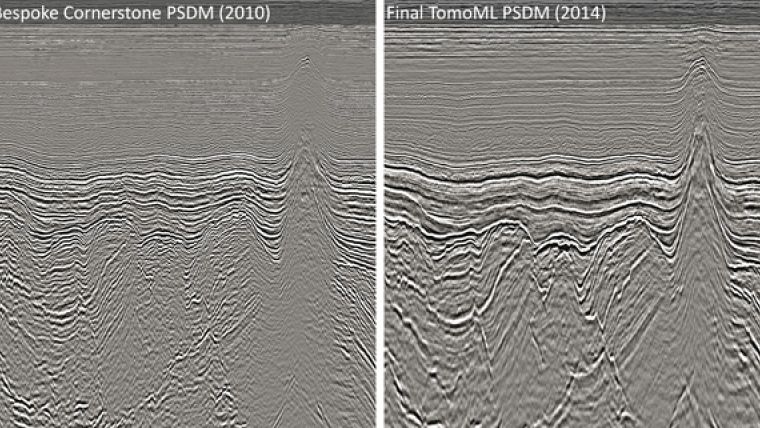PSDM Brings Understanding in Central North Sea
Although the Central North Sea (CNS) is a mature basin, it is still rich in opportunities for the development and discovery of new fields as the area is notoriously challenging for seismic imaging, especially in the deep high-pressure high-temperature (HPHT) part of the Central Graben. However, CGG’s Cornerstone dataset benefits from a portfolio of new technology to address these imaging challenges, creating new opportunities. The advanced ghost wavefield elimination (GWE) technique has been applied to the legacy Cornerstone data to extend the bandwidth as near as possible to the new BroadSeis data, so that it can be merged to create a contiguous broadband pre-stack depth-migrated (PSDM) dataset.
The entire volume has been enhanced to capitalise on recent developments in broadband technology, velocity modelling and demultiple. Recent phases of acquisition have used BroadSeis variable-depth streamers, and the most recent employed the BroadSource broadband source, delivering ghost-free data with over six octaves of bandwidth.
With four octaves of signal below 40Hz, BroadSeis provides the best resolution for imaging below the Base Cretaceous Unconformity (BCU). Combining BroadSeis with BroadSource also delivers high frequencies up to the sampling Nyquist frequency for incredible resolution of shallow channels and geohazards.
The bandwidth achievable depends on the signal-to-noise ratio in the recorded data, so the ultra-low frequencies of BroadSeis true broadband data cannot be obtained. Nevertheless, considerable improvements have been delivered, providing a 35,000km2 broadband PSDM dataset.
New demultiple techniques such as Model-based Water-layer Demultiple (MWD) and Internal Multiple Modelling (IMA) have been applied to this dataset and deliver vast reductions in the multiple contamination that has historically afflicted CNS datasets.
Large-scale Quaternary channelling in the near surface strongly influences the imaging of deeper data. Recent advances in Full Waveform Inversion (FWI) and Dip-Constrained Tomography have enabled highly detailed velocity models to be built incorporating these channels, resulting in more accurate imaging of deeper events. There are also complex structures with strong velocity contrasts found here, often located at great depths, where limitations of available data may restrict velocity and anisotropy modelling. Multi-layer Tomography (TomoML) brings stability and accuracy to velocity modelling in such areas, producing more geologically plausible models, and providing improved imaging results. Applying these techniques to the entire Cornerstone dataset with extensive well control has produced a regional anisotropic PSDM dataset with better local detail and definition than previous proprietary datasets tailored to specific local targets.
The new E-W oriented Cornerstone Phase 8 BroadSeis-BroadSource survey overshoots the existing conventional long-offset, N-S oriented data. This new survey has been combined with the reprocessed earlier data to provide a dual-azimuth volume over the HPHT area of the Central Graben, with all the inherent benefits of dual-azimuth data: increased sampling, options to apply true 3D processing algorithms for better noise and multiple attenuation, improved illumination beneath the Base Cretaceous and optimal imaging of subtle features such as four-way closures due to more accurate velocity and anisotropy models. The dataset shows significant improvements in imaging below the BCU, and may indicate the future path of North Sea acquisition. In addition to the best-quality seismic data, CGG also provides advanced value-added Pore Pressure Prediction (PPP) and Facies Finder products over Cornerstone to aid the understanding of existing and potential new reservoirs.
PPP provides volumetric estimates of pore pressure across the deep part of the Central Graben to identify potential drilling hazards and improve well positioning. CGG combines expertise in high-resolution seismic velocities, petrophysical modelling and well data integration to deliver a range of seismic pore pressure services. This is available over approx. 15,215 sq. km of potential HPHT data in Central Graben.
Facies Finder maximises the value of seismic data early in the exploration and production cycle to highlight and de-risk potential prospects. It provides easy-to-interpret pre-stack attribute volumes for lithology and fluid identification using a relative elastic inversion requiring no well calibration, so is suitable for exploration and screening for AVO anomalies.
The reprocessed merged Cornerstone dataset delivers an unprecedented volume of high-quality anisotropic broadband PSDM data over a huge area of the Central Graben of the CNS, including the HPHT area. This regional dataset is available now, delivering the local detail required to assess new license awards, complemented by Facies Finder over the whole dataset, and Pore Pressure Prediction data over the HPHT areas.
Image: Comparison of new regional Cornerstone PSDM data with previous locally tailored data.














